What does a ball of yarn, a quilt, a Makespace, the Honey Bee, a podcast, Green Smoothie and a Minecraft Museum all have in common?
The following is an example Inquiry Lesson that infuses Maker Space, Collaborative tools, Inquiry and Design thinking, including Minecraft. We facilitated this lesson at the Enrichment and Innovation Centre in our Grade Six Journalism Program, for Gifted Students.
This Video is the lesson consolidation. Everything is connected. “How Wolves Change Rivers”.
Interconnectivity.
We ask: Is Interconnectedness essential for our survival?
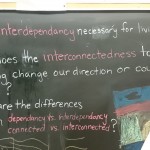 *How does the interconnectedness of anything change its course or direction in life?
*How does the interconnectedness of anything change its course or direction in life?
*What does it mean to depend on someone or something?
*Will the disappearance of the honey bee impact human life at the local to international level? In what ways?
*How can we strengthen our own connectedness to the earth? To each other?
Curriculum Connections:
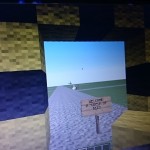
Social Studies: People and Environments, Political and Physical Regions of Canada (Ontario Curriculum) For More Detailed Curriculum follow this link
Connections to Sustainable Development Goals:
Goal 15: Protect, restore and promote sustainable use of terrestrial ecosystems, sustainably manage forests, combat desertification, and halt and reverse land degradation and halt biodiversity loss
Goal 13:Take urgent action to combat climate change and its impacts
Goal 3: Ensure healthy lives and promote well-being for all at all ages
Pre-Lesson and Critical Literacy/Inquiry
To begin, we would use a “Flipped” approach. First, students would be given a task to investigate content related to the local and global issue of disappearing bees. Students explore, find, read,watch/listen and discover information related to why honey bees are disappearing. Second, students are asked to bring a leafy green vegetable and a fruit (and any type of super food such as chia or hemp). Contributing means feeling part of something and recognizing the value you bring in- your importance. This piece is vital. It strengthens community and builds trust.
EXAMPLE LETTER: LINK
YES, Space is IMPORTANT!
Room Design, Bulletin Boards and Relevant Activities (Self-Directed Activities)
Kitchen (connection back to home/family)
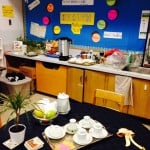 Mock kitchen is created. Vegetables are displayed along with a nutritional information focus; Students would also share in a Tea Circle Discussion upon arrival (as they do most days); The kitchen would also have an assortment of plants (especially those with obvious pollen); A variety of honey types would be on display for students to explore the texture and taste and begin to make personal connections to the topic.
Mock kitchen is created. Vegetables are displayed along with a nutritional information focus; Students would also share in a Tea Circle Discussion upon arrival (as they do most days); The kitchen would also have an assortment of plants (especially those with obvious pollen); A variety of honey types would be on display for students to explore the texture and taste and begin to make personal connections to the topic.
Science:
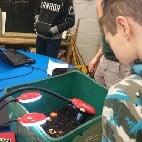 There is also a worm compost bin (vermi composting) to maintain the importance of connections and emphasize the value balancing what we take and give back to the earth.-Flowering plants on display for students to explore with microscope; A variety of informational videos available.
There is also a worm compost bin (vermi composting) to maintain the importance of connections and emphasize the value balancing what we take and give back to the earth.-Flowering plants on display for students to explore with microscope; A variety of informational videos available.
Living Room Area (literacy)
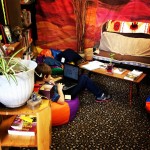
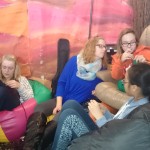
Word wall and activities; Knitting/crochet activities (in shape of honeycomb; Sewing (creating a beehive pattern activity); A variety of books, magazines, newspapers and literature
Math Area
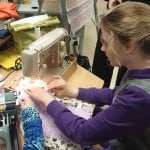 Collaborative puzzle for hands-on activities (an explicit way to demonstrate the connectedness of each individual piece and its necessity for the whole); A display that demonstrates facts and data, along with inquiry questions; A map display showing areas that are impacted; Honey Comb is be available to help students learn about the geometry of the Bee Hive and how the HoneyComb is made.
Collaborative puzzle for hands-on activities (an explicit way to demonstrate the connectedness of each individual piece and its necessity for the whole); A display that demonstrates facts and data, along with inquiry questions; A map display showing areas that are impacted; Honey Comb is be available to help students learn about the geometry of the Bee Hive and how the HoneyComb is made.
Maker and Art Space
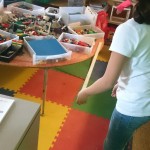
Students will have access to lego; Sewing Machine Activities; 3D printer; Programming activities (using scratch to program geometric shapes);Green Screen applications; Pencil Sketching, Math and GeometryDesigning
Introductory
 With a cup of tea, the lesson will begin around the “Kitchen Table” where we will feel, touch, smell and taste some of the fruits and veggies that will go into the Smoothies. We will discuss how the veggies change their attributes and nutritional impacts when the are paired with one another (i.e., vitamin C with Iron). As a group we begin asking questions about what we know and don’t know about the vegetables, their interconnections to each other as well as to the earth. We will ask, what would happen if they weren’t available?
With a cup of tea, the lesson will begin around the “Kitchen Table” where we will feel, touch, smell and taste some of the fruits and veggies that will go into the Smoothies. We will discuss how the veggies change their attributes and nutritional impacts when the are paired with one another (i.e., vitamin C with Iron). As a group we begin asking questions about what we know and don’t know about the vegetables, their interconnections to each other as well as to the earth. We will ask, what would happen if they weren’t available?
Here, we would begin our inquiry.
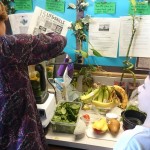 Following our Tea Circle, students will begin an independent exploratory activity where they will participate in a ‘shared’ Google Document and contribute to collaborative inquiry. (Here, a link is created by opening the document to anyone with link to make the process efficient.) Students contribute to information search focusing solely on the specific foods they brought in (or assigned to) and make explicit connections to nutrients. They use the information to create recipes that focus on a certain need or ailment.
Following our Tea Circle, students will begin an independent exploratory activity where they will participate in a ‘shared’ Google Document and contribute to collaborative inquiry. (Here, a link is created by opening the document to anyone with link to make the process efficient.) Students contribute to information search focusing solely on the specific foods they brought in (or assigned to) and make explicit connections to nutrients. They use the information to create recipes that focus on a certain need or ailment.
We call it “Brain and Body On”.
LINK to the DOCUMENT
- We would later use this activity to make the connection that healthy foods are a necessity in our lives and begin the inquiry of WHY so many people continue to suffer obesity and health problems – relating this to our connections to the people and world around us.
- We would discuss Nutrition in the context of wealth and poverty and further explore the Global Goals.
- We would connect this to the biodiversity of our planet and examine the impact – the cause and effects of loss and gain. Students would see the chain reaction of how a honey bee can impact the lives of humans, food and climate change, and the impact this has for Ontario Farmers, Trade relations and cost of food. This article would provide a context: http://www.davidsuzuki.org/what-you-can-do/food-and-our-planet/food-and-climate-change/
- We would connect this to rising prices of fruits and vegetables due to lower yields of farmer crops, to the grocery store and finally to the consumer. We would discuss Trade. This link would provide a context: http://www.cbc.ca/news/business/loonie-grocery-costs-1.3399841
- Students would discover that this loss would perpetuate poverty and would lead to a health crisis since our most valuable resources (as they’ve discover) are only accessible to people who can afford the high costs.
Minds-on & Hands-On
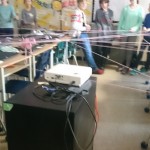 Together: Students begin the day, together in a large circle (this process helps students understand the impact of being connected and interconnected). Students are encouraged to be mindful of the fact that they all share in the moment, the day. One by one, students pass a ball of yarn while celebrating and sharing one connection (a team, a family, a friend, a book…). They form a web of direct and indirect connections and would learn that they can be impacted indirectly when the yarn is yanked or dropped by anyone in the circle, even those that aren’t directly linked.
Together: Students begin the day, together in a large circle (this process helps students understand the impact of being connected and interconnected). Students are encouraged to be mindful of the fact that they all share in the moment, the day. One by one, students pass a ball of yarn while celebrating and sharing one connection (a team, a family, a friend, a book…). They form a web of direct and indirect connections and would learn that they can be impacted indirectly when the yarn is yanked or dropped by anyone in the circle, even those that aren’t directly linked.
- compare this to our connections to our planet, to other living organism, to the foods we eat, to others – near and far.
- bring this realization of interconnectedness back to the Big Idea (Is interconnectedness essential for our survival?)
Individual: Students are given time to explore hands-on activities provided throughout the classroom – all that demonstrate concepts of interconnectedness. This can be done at the start of class (when they arrive, or throughout the class as time allows.
- puzzles
- knitting, crocheting (co-creating a quilt)
- sewing
- Circuits and Programming activities
- 3D printing
- Creating Smoothies
(Assessment Opportunity – Teacher/Student time)
Inquiry – Student Driven:
As a class, students create a COLLABORATIVE book that identifies a variety of topics/issues involving the plight of the honey bees and the interconnectedness of the environment and humans. Together, students create a list of issues involving the disappearing bees ( focus on trade, farmers crops, use of pesticides, GMO’s, cause and effect on environment…). Upon completion, each of the Inquiries will be posted.
List of topics will focus on specific learning curriculum expectations
*connections between natural environment, employment, jobs and consumer (relating to bees)
*Jobs, land and organizations dependent on survival of bees
*Impact and connection of environment effects and land use (cause and effect)
*Environmental issues at an international scale and its impact on Canada
In partners or individually, students are given a full period (or more) to research and discuss the topic of their choice, but always relating it back to the inquiry topic of the Honey Bee and its interconnected value to the world.
Staying engaged… feeding the body and soul…
*Note – Throughout “Worktime”, students will have an opportunity to make SMOOTHIES based on their recipes and ingredients (from earlier activity). During this small group time, students will be asked to share how the ingredients and the nutrients are directly connected to their inquiry topic. AT this time, we will make connections back to the land and its impact on farming and then back to the consumer.
(Assessment Opportunity – Teacher/Student time)
Product (Culminating) – What are students working to create/produce?
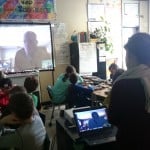 *Podcast – Students learn to use Audacity and begin exploring podcasting techniques. As part of Interconnectivity, students use SKYPE to discuss Podcasting techniques with an expet in podcasting -Rodd Lucier.. Students are given examples and podcasting techniques -how to express voice, to conduct an interview, to use voice to convey a message, etc. Students will create a podcast interview, informational podcast or a skit.
*Podcast – Students learn to use Audacity and begin exploring podcasting techniques. As part of Interconnectivity, students use SKYPE to discuss Podcasting techniques with an expet in podcasting -Rodd Lucier.. Students are given examples and podcasting techniques -how to express voice, to conduct an interview, to use voice to convey a message, etc. Students will create a podcast interview, informational podcast or a skit.
*Blog – Students upload their podcast to their blog along with a blog describing the topic and inquiry question.Students have a prior knowledge of blogging. They will be reminded to use more than one medium in their blog and to end their blog with an inquiry question.
*Collaborative Book – Students will contribute to a Collaborative book using OneNote or Google Drive
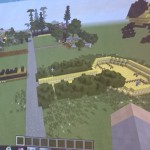 Students will add their information to the WHOLE class creation using Google Drive or OneNote, thus demonstrating and participating in a connected activity
Students will add their information to the WHOLE class creation using Google Drive or OneNote, thus demonstrating and participating in a connected activity
*MinecraftEDU – Students will design their solution or their information topic in a collaborative world. Here students will design a collaborative museum, where they will add their information through design and interactivity.
Assessment
Learning criteria will be established with the students. As a group we will discuss some of these expectations:
- Research and Information produced must contain local and international data that explains a topic.
- Students address connections to themselves as well as looking at connections at a large scale (consumer, poverty, land use)
- Students will ask relevant and critical questions as part of their research
- Students recognize the impact that the topic has at a larger scale and discuss reasons for this
- Students use appropriate vocabulary
- Students recommend solutions
Specific Expectations
*describe some major connections between features of the natural environment and the type of employment that is available in a region, with reference to two or more municipal regions in Ontario
* “Why are some jobs dependent on the seasons?” “What are some of the jobs that are connected to forests, lakes, and rivers? What sorts of jobs are connected to agricultural land use?”
*gather and organize a variety of data and information on the environmental effects of different land and/or resource use and measures taken to reduce the negative impact of that use
*evaluate evidence and draw conclusions about issues related to the impact of natural resource extraction/harvesting and/or use around the world
*communicate the results of their inquiries using appropriate vocabulary (e.g., non-renewable, renewable, flow resources; extraction; sustainability; deforestation; fossil fuels; aquifer) and formats appropriate for specific audiences
*explain why some environmental issues are of international importance and require the participation of other regions of the world, along with that of Canada, if they are to be effectively addressed

